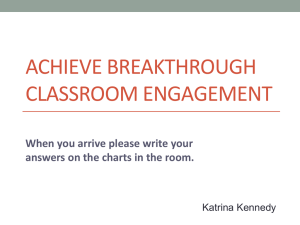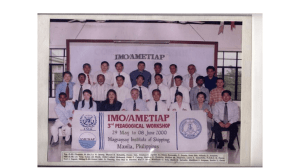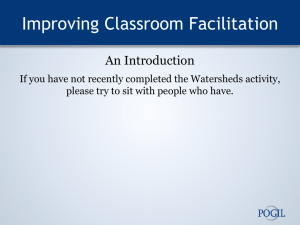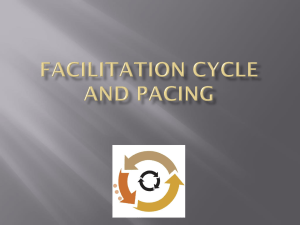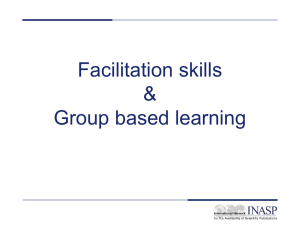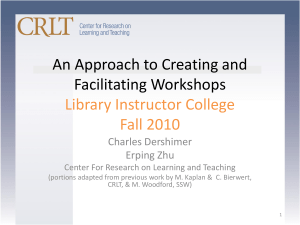Performance
advertisement
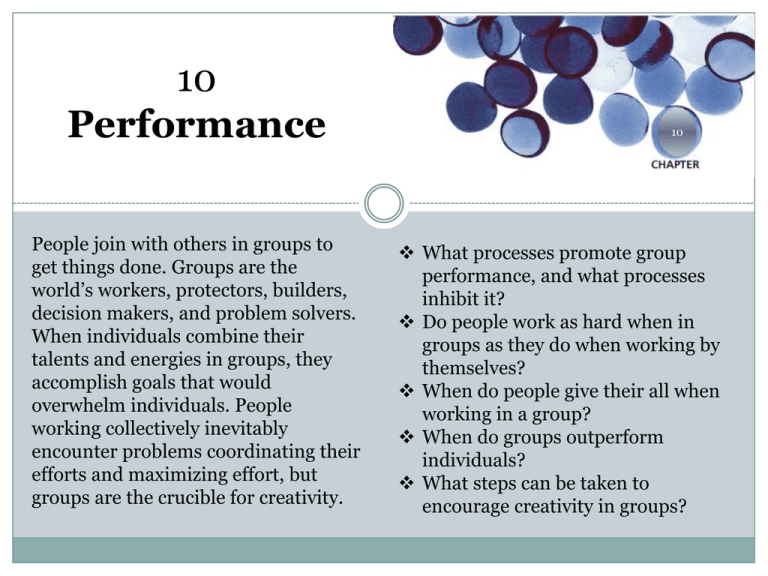
10 Performance People join with others in groups to get things done. Groups are the world’s workers, protectors, builders, decision makers, and problem solvers. When individuals combine their talents and energies in groups, they accomplish goals that would overwhelm individuals. People working collectively inevitably encounter problems coordinating their efforts and maximizing effort, but groups are the crucible for creativity. 10 What processes promote group performance, and what processes inhibit it? Do people work as hard when in groups as they do when working by themselves? When do people give their all when working in a group? When do groups outperform individuals? What steps can be taken to encourage creativity in groups? Working in Groups Groups with a Purpose When to Work in Groups The Process Model of Productivity Social Facilitation Performance in the Presence of Others Why Does Social Facilitation Occur? Conclusions and Applications Social Loafing The Ringelmann Effect Causes and Cures Collective Effort Model Groups vs. Individuals Additive Tasks Compensatory Tasks Group Creativity Brainstorming Disjunctive Tasks Improving Brainstorming Conjunctive Tasks Alternatives Discretionary Tasks Process Gains in Groups Working in Groups • What happens when Groups a others people joinwith with Purpose on the most simple of tasks? When Workmake • Do manytohands Groups lightinthe work? • Are people prone to “freeThe ride?” Process Model of Productivity • Are we better (smarter, more clever, more creative) together? Groups with a Purpose McGrath’s task circumplex model distinguishes between generating, choosing, negotiating, and executing tasks. These tasks differ along two dimensions: conceptualbehavioral and cooperation-conflict. The tasks groups complete are numerous and varied. When to Work in Groups Collective Intelligence Groups working on many different types of tasks performed better when: They included more women Members where higher in social sensitivity Members contributed at relatively equal rates to the task When Groups? How difficult is the task? How complex is the task? How important is the task? How monotonous/dull is the task? Steiner’s Theory of Process and Productivity Ivan Steiner (1972), in his classic work Group Process and Productivity, drew on the concept of process loss to predict when groups will perform well or poorly. Process loss: Reduction in performance effectiveness or efficiency caused by actions, operations, or dynamics that prevent the group from reaching its full potential, including reduced effort, faulty group processes, coordination problems, and ineffective leadership. Steiner’s Law of Productivity AP = PP – PL Actual productivity is equal to Potential Productivity Less Process Loss Working in Groups Groups with a Purpose When to Work in Groups The Process Model of Productivity Social Facilitation Social Loafing Groups vs. Group Social Facilitation Creativity Individuals Performance in thefacilitation: improvement in Social Presence of performance in the presence of others Others and coaction) audience (both Why Does Social Triplett’s Facilitation(1898) early study of the influence of other people on performance of simple tasks Occur? Conclusions and Applications Performance in the Presence of Others Zajonc’s motivational analysis of social facilitation (1965) Social facilitation occurs on simple tasks that require dominant responses Presence of others Dominant responses increase and Social interference occurs for complex tasks that require nondominant responses Task requires dominant responses Social facilitation Performance gain nondominant responses decrease Task requires nondominant responses Social interference Performance loss Empirical Examples: Zajonc’s Cockroach Study Performance in the Presence of Others Speed in seconds 140 120 100 80 Coacting Alone 60 40 20 0 Simple Complex Type of Maze Seconds Performance in the Presence of Others Markus (1978): Donning familiar and unfamiliar garb 40 35 30 25 20 15 10 5 0 Alone Watched Present Familiar Unfamiliar Type of Task Why Does Social Facilitation Occur? Theories of social facilitation Two types of responses in performance settings • Challenge response • Threat response Why Does Social Facilitation Occur? Theories of social facilitation Why Does Social Facilitation Occur? Harkin tested his mere-effort model using the Remote Associates Test (RAT) Theories of social facilitation Star Glass Stamp Carpet High Why Does Social Facilitation Occur? Theories of social facilitation Conclusions and Applications Eating in groups Prejudice as a dominant response Electronic performance monitoring (EPM) Learning in groups • Cross-cultural differences Working in Groups Social Facilitation Social Loafing Groups vs. Individuals Group Creativity The How productive are people when they work on simple group tasks? Ringelmann Effect Causes and Cures Collective Effort Model Steiner’s Law of Productivity AP = PP – PL Actual productivity is equal to Potential Productivity Less Process Loss The Ringelmann Effect Ringelmann effect: The tendency, first documented by Max Ringelmann, for people to become less productive when they work with others; this loss of efficiency increases as group size increases, but at a gradually decreasing rate. People become less productive when they work with others Causes and Cures Latané, Williams, and Harkins disentangled the effects of both coordination loss and social loafing in their studies of groups and “pseudo-groups” generating sound. Motivation loss Coordination loss Obtained output Potential Productivity Pseudo groups Actual groups Ways to Increase Social Motivation Increase identifiability Social compensation processes also work, in some cases, to reduce process loss by increasing the level of effort expended by others in the group Minimize free-riding by making the group as small as possible (6 ± 2) Set goals (specific, clear) Increase engagement by building in interdependence Increase identification with the group (self < group) Karau & William’s CEM applies motivation theory to motivation in groups Collective Effort Model Must share the rewards with others Expectations Performance Even if you work hard other group members may not Rewards Valence Loss of motivation in groups Motivation Group rewards not as valued as personal rewards Working in Groups How well will aSocial group perform? suggests Social GroupsSteiner vs. Group it all depends on the type of task theCreativity group is Facilitation Loafing Individuals attempting. Additive Tasks Task demands are defined by divisibility, the Compensatype of output desired, and the social tory Tasks combination rule used to combine individual Disjunctive members’ inputs. Tasks Divisibility QuantityConjunctive or Interdependence Quality? Tasks Discretionary Tasks Can the task be broken down into sub-tasks? Is quantity produced Process more Gains in important Groups than the quality of the performance? How are individual inputs combined to yield a group product? Steiner’s Analysis of Task Demands Groups outperform individuals on additive tasks, but at a decreasing rate of gain. Additive Tasks Potential Productivity 100 90 Relative Performance 80 70 Projected Productivity 60 50 40 30 20 10 0 1 2 3 4 5 6 7 Group Size 8 9 10 Compensatory Tasks Even a small group (8 members) was wiser than an above-average single member. The “Wisdom of Crowds” effect occurs (sometimes) if members’ judgments are averaged Once the group reached 40 members, it became wiser than the best members. Compensatory Tasks The “Wisdom of Crowds” effect did not occur if problem was very difficult Individuals routinely outperformed the ignorant crowd. Disjunctive Tasks Groups perform well on disjunctive tasks if the group includes at least one individual who knows the correct solution. • The truth-wins rule usually holds for groups working on Eureka problems • The truth-supported-wins rule holds for groups working on nonEureka problems. • Groups are better at problems that have a known solution (intellective tasks) rather than problems that have no clear right or wrong answer (judgmental tasks). Conjunctive Tasks Groups perform poorly on conjunctive tasks since the group’s outcome is substantially influenced by its “weakest link.” Group improve at such tasks if they can be subdivided and each task assigned to the person most capable of performing it. When the Kohler effect occurs, the poorest performing member improves his/her performance to keep up with the others. Discretionary Tasks The effectiveness of groups working on discretionary tasks covaries with the method chosen to combine individuals’ inputs. Process Gains in Groups The search for synergy-achieving collectively results that could not be achieved by any member working alone – continues, but synergy is VERY rare. Synergy is so rare that Steiner’s Law does not include a “Process Gain” element: AP = PP – PL + PG Working in Groups Social Facilitation Social Loafing Brainstorming rules Be expressive Postpone evaluation Seek quantity Piggyback ideas Groups vs. Individuals Additive Tasks Compensatory Tasks Group Creativity Brainstorming Disjunctive Tasks Improving Brainstorming Conjunctive Tasks Alternatives Discretionary Tasks Process Gains in Groups Maximizing Creativity in Groups Problems with Brainstorming Social loafing Production blocking Social matching Illusion of productivity Alternatives brainwriting synectics nominal-group technique (NGT) electronic brainstorming (EBS) Delphi Buzz groups Working in Groups Groups with a Purpose When to Work in Groups The Process Model of Productivity Social Facilitation Performance in the Presence of Others Why Does Social Facilitation Occur? Conclusions and Applications Social Loafing The Ringelmann Effect Causes and Cures Collective Effort Model Groups vs. Individuals Additive Tasks Compensatory Tasks Group Creativity Brainstorming Disjunctive Tasks Improving Brainstorming Conjunctive Tasks Alternatives Discretionary Tasks Process Gains in Groups
